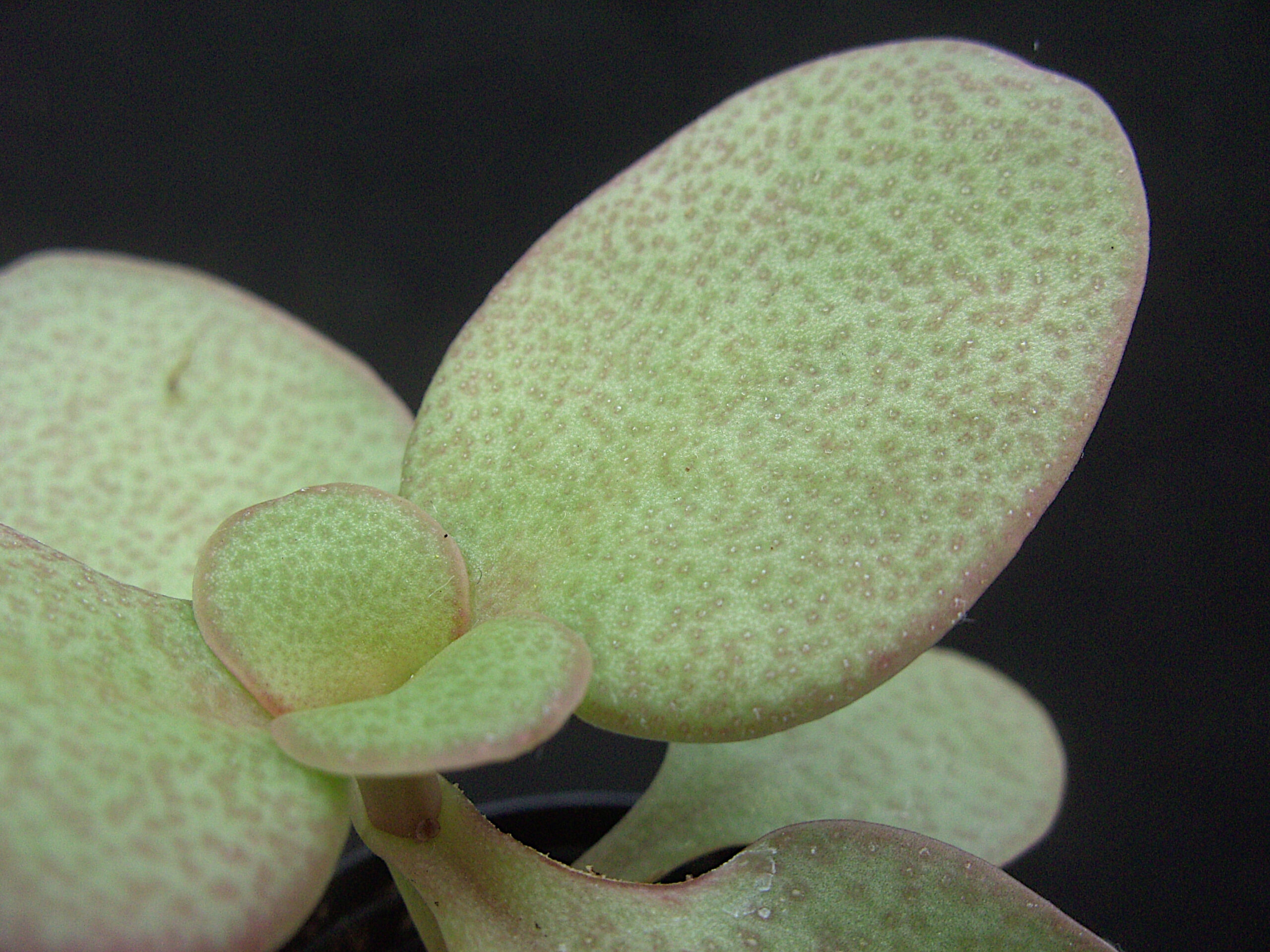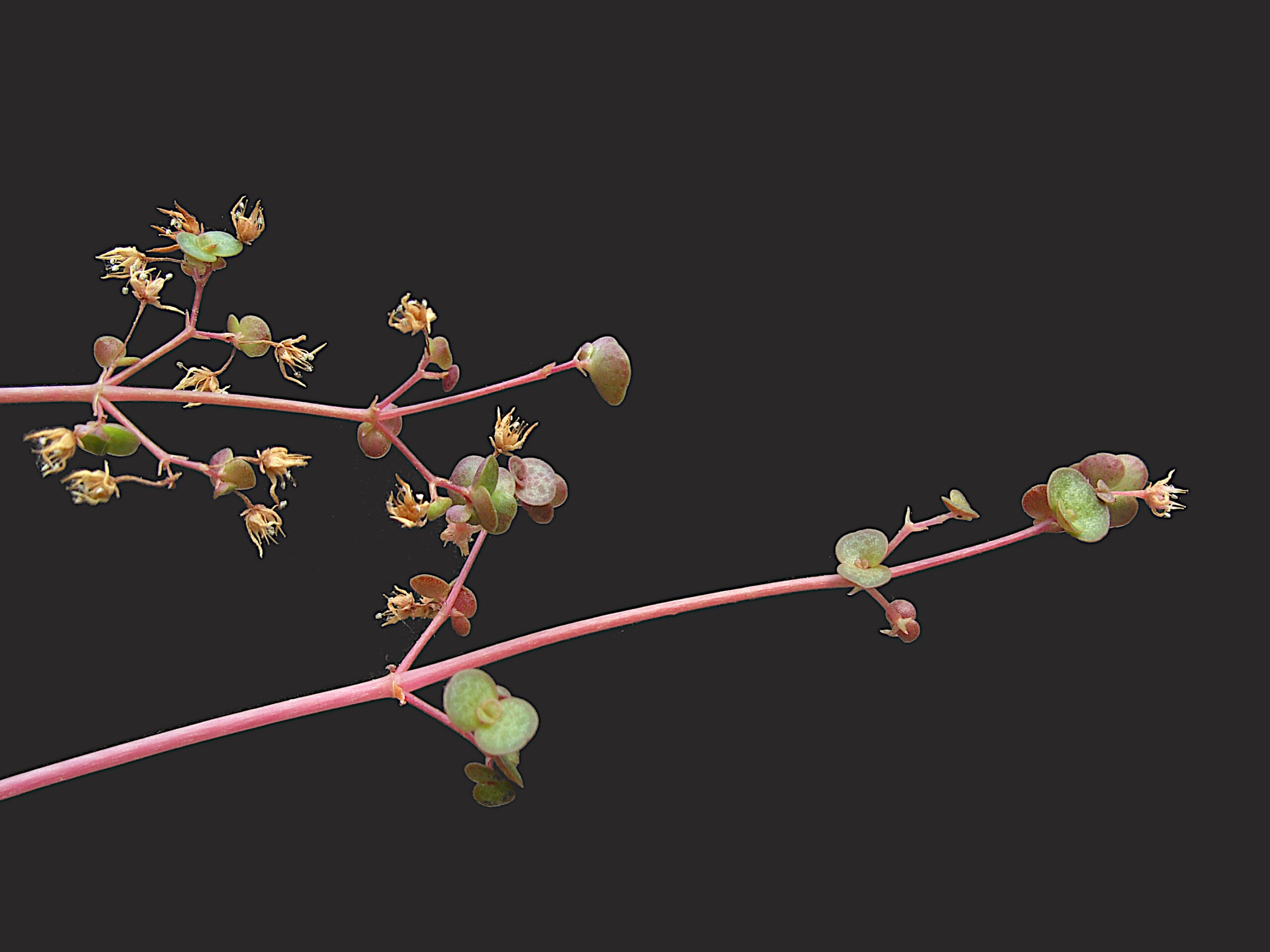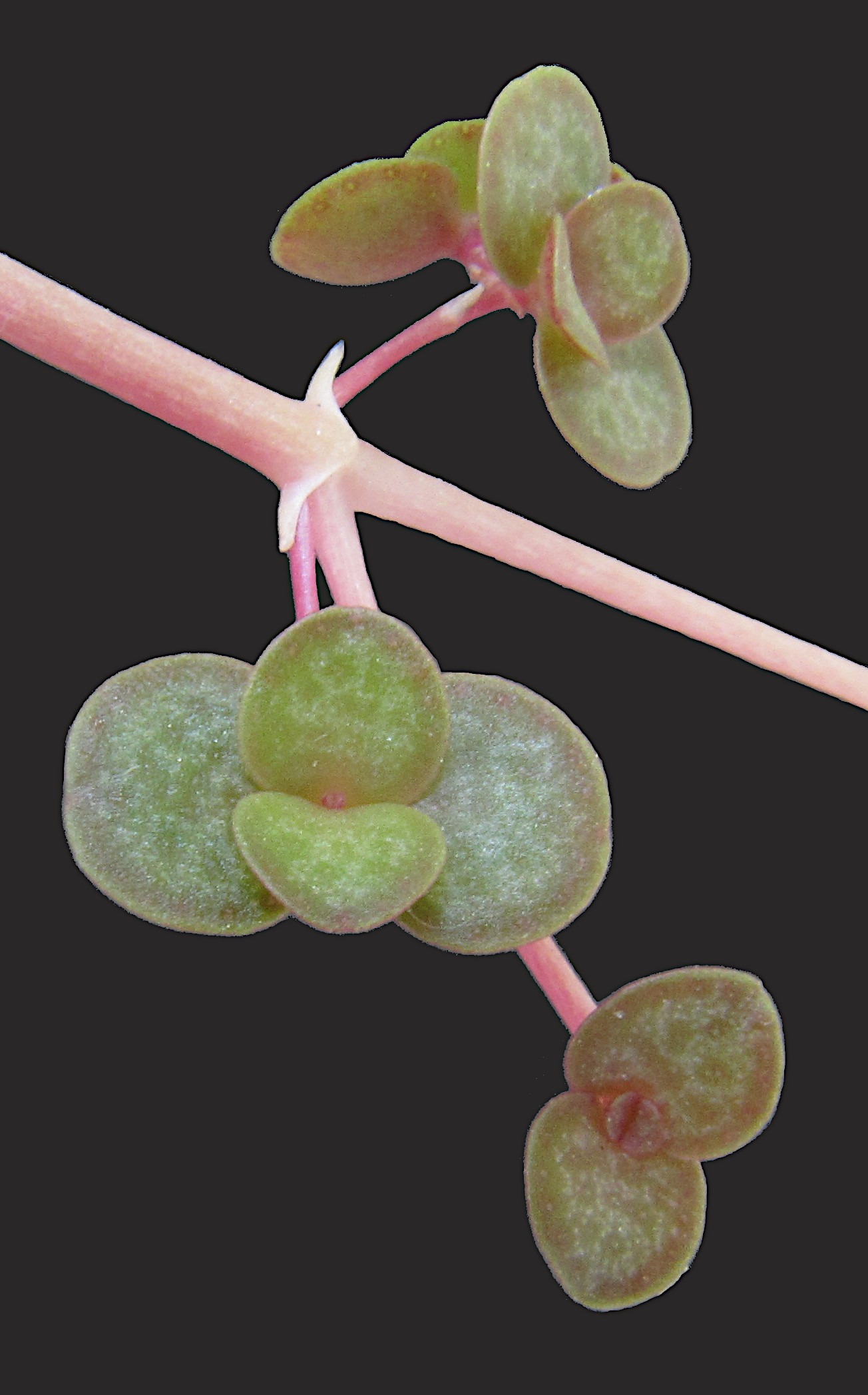Crassula multicava
(Guest column by Theo Heijnsdijk)

Crassula multicava (Fig. 1) is a sparsely branched plant with fleshy stems up to about 30 cm long and 1 cm thick. Long stems lie down and form new roots and branches from the leaf axils. The leathery leaves are up to 6,5 cm long and 4 cm wide. Towards the stem, each leaf narrows down to a petiole (leaf stalk), which is fused with that of the opposite leaf, giving the impression that the stem has grown through them.
C. multicava occurs in South Africa (Mpumalanga, KwaZulu-Natal, Eastern Cape) and was described by Lemaire as early as 1872. Multicava means: with many cavities. This refers to the upper side of the leaf, which is littered with many round dimples, somewhat like an orange (see Fig. 2 below),
 Fig. 2
Fig. 2
(giving rise to the name ‘Pitted Crassula’. The dimples are so-called hydathodes, a name for glands that can excrete moisture. Such glands occur in many plant genera and can be of different anatomical origins. In Crassulas, they are converted stomata. As a rule, hydathodes are intended to get rid of excess moisture, but that sounds rather strange for succulents, who need to lose as little moisture as possible. Gordon Rowley in his book ‘Crassula’ suggests the possibility that during the day when temperatures are very high, air bubbles are formed in the vascular system of the plant so that the juice flow is blocked (embolism), comparable to air bubbles in a garden hose. At night, the plant would then supply extra water from the roots, thereby increasing the pressure so that the air dissolves back into the plant juice. Then the excess water must evaporate again via the hydathodes. Rowley invites readers to come up with a better theory.

In a shady place, the leaves are fairly light green (Fig.3 above).
In a sunny position, they stay smaller and are much darker green with the leaf edges and hydathodes turning brownish-red. By the way, in dappled shade, they also grow better than in full sun. In Afrikaans, the plant is not called ‘skaduplakkie’ (shadow crassula) without reason.
My first introduction to the species was during the Christmas holidays of 2005, when I stayed on the Canary Island of Gomera. I went for a walk near the apartment and came across a garden in which the soil was covered with a layer of perennial succulents with lots of pink flowers. By the way, the plant had not kept to the boundaries of the garden. Of course, there was no name sign. In May 2008, I saw the plant for a second time (now properly labeled), as a ground cover in a bed with other succulents in a greenhouse of the Botanical Garden of Berlin.
In my greenhouse (in the Netherlands) the plant blooms abundantly from March /April until well into autumn. The flowers are rather loosely arranged in the inflorescence, which results in a somewhat unkempt look. (Fig. 4 below).

Fig. 4
It reminds one of a cloud of mosquitoes and I think that is why the plant is sometimes called the ‘Mosquito Flower’ in America.
Crassula flowers perfectly conform to the prototype of a flower as you find in, for example, a biology book for schools. From the outside going to the centre, one first comes across the calyx leaves, then, alternating in position relative to these, the same number of petals, then alternating again, the same number of stamens and lastly, in alternating position again, the same number of pistils on top of the ovary. Such a flower structure with all this in equal numbers is called isomerous. With most Crassulas, the flowers are 5-merous, so 5 of all the above parts, but in C. multicava the flowers are usually 4-merous. They are white inside and pink on the outside (Fig. 5).

Fig. 5
The appearance of the star-shaped pink flower is the reason that the plant is called ‘feetjie plakkie’ or ‘feetjie crassula’ in Afrikaans. A feetjie is a fairy in English, so there it becomes fairy crassula. In Australia, the plant is called ‘London Pride’, because the plant in flower resembles Saxifraga ‘London Pride’, used as a ground cover in England. By the way, ‘London Pride’ is also the name for a multi-award-winning English beer variety.
Due to the large number of flowers, the flowering stems bend to the ground. By the time the flowering season ends, miniature versions of the plant (called bulbils, see Fig. 6 and 7 below) appear here and there on the flower stalks.

 Fig. 7
Fig. 7
This is quite normal for some Kalanchoes (Bryophyllums), but exceptional in the genus Crassula. These plantlets easily become detached from the mother plant and then quickly take root. This way, in a suitable climate such as in the Canary Islands, the plant can become a pest. The name ‘Cape Province Pygmy weed’ also refers to the rampant character. I don’t know what it has to do with pygmies, but maybe it only refers to the small size of each plant.
The regenerative capacity of C. multicava is phenomenal. As early as 1938, a scientific paper was published describing how new plants can emerge from epidermis cells of small cut-off pieces of leaf. In these times of tissue culture, this may not sound so spectacular, but at the time it was considered a unique trait.
Rowley attributes the great regenerative capacity and the forming of bulbils to the large number of chromosomes of C. multicava. As we know, almost all hereditary information of an organism is recorded on the chromosomes, which are located in the nucleus of each cell. In general, in a nucleus there are 2 sets of chromosomes, 1 set originated from the father and 1 set from the mother. This is called diploid and the number of chromosomes is then indicated as 2n. The number of chromosomes in a set is indicated by the letter x. Normally, x = n. For a fruit fly x = 4 applies, for a human x = 23, for a guinea pig x = 32 and for most Crassulas x = 7. A human being has 2n = 2x = 46 chromosomes. In some species there are more than 2 sets and such a cell is called polyploid. In plant species that are normally diploid, polyploidy often leads to larger individuals or larger flowers. In Crassula, no less than 44% of the species are polyploid. The champion is C. spathulata with 2n = 20x = 140, which indicates 20 sets of 7 chromosomes per cell nucleus. C. multicava comes second with 2n = 16x = 112, so 16 sets.
I must admit that the link between a high number of chromosomes and a high reproductive capacity is not clear to me. Of other polyploid Crassulas it is not recorded that they reproduce so easily and neither do they do form bulbils, whereas C. cordata, which does make bulbils, is just diploid. Maybe someone should come up with a better theory here, too.
As for cultivation: frost-free, although they seem to be able to endure a single bit of frost without damage. Otherwise indestructible. The plant also grows well in shade.
There is a subspecies, C. multicava subsp. floribunda. This one is a bit more robust in all parts and the flowers are 5-merous. It has a cultivar, C. multicava subsp. floribunda ‘Panache’, in which the edges of the leaves are whitish-yellow. C. multicava subsp. multicava, on the other hand, has a forma ‘Variegata’ in which the leaves are green at the edges but yellow in the centre.
Literature:
Harders, C.L. (1932). Crassulaceae, Succulenta 15 (11): 207.
Rowley, G. (2003). Crassula, Cactus & Co.
McVeigh, I (1938). Regeneration in Crassula multicava, American Journal of Botany 25: 7 -11.
First published in Succulenta 90, (1) 2011. Translated from Dutch by FN.
Thank you for the interesting information and the great read!
Many thanks for your kind words!